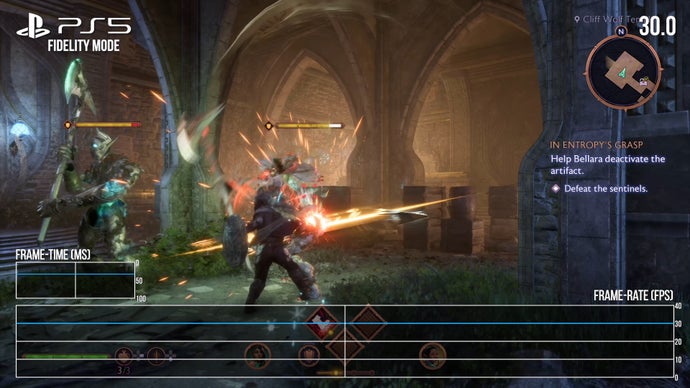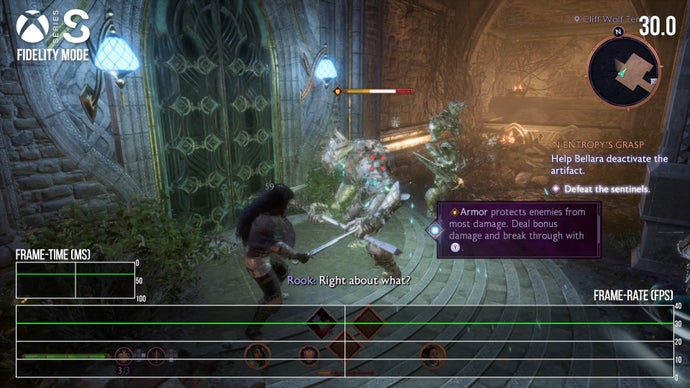After a decade of development and project restarts, the latest Dragon Age is finally here. Dragon Age: The Veilguard is a direct sequel to 2014’s Inquisition, and uses a dramatic evolution of that game’s Frostbite technology, featuring ray tracing techniques and current-gen exclusivity. We’ve already covered the PC version and came away impressed with how the new release scales across a range of hardware, but where does that leave the consoles – especially the four teraflop Xbox Series S? And how have the game’s ray tracing settings been adapted for console play?
Dragon Age: The Veilguard is a great-looking game. I wasn’t all that taken by early previews, but with the game actually in hand I think it’s clearly a very handsome title. There are some really beautiful environments here, with abundant foliage and attractive lighting. It’s not necessarily going to stand toe-to-toe with this generation’s top tier in terms of reflections or diffuse global illumination quality, but the overall image is impressive.
One element that highlights the experience is the game’s strand-based hair system. The developers have taken and adapted Frostbite’s hair system here (as seen in the FIFA/FC games) which provides an impressive combination of refined hair detail with realistic movement and flow. In virtually any gameplay or cutscene situation, my character’s long curled locks produced a visually satisfying result with minimal clipping – and that applies to essentially all the hair featured in the game, regardless of length or texture. It may seem odd to focus on the hair rendering first and foremost – but it’s a striking feature that is original and distinct.
That hair is featured quite nicely in the game’s character creator, which provides a lot of options for character designs without feeling overwhelming. The rounded-off, exaggerated features ensure the characters don’t dip into the uncanny valley. It’s a little more guided than creating a character in a Bethesda game, but I feel like it provides a similar level of flexibility – and of course it’s easy to skip through if you just don’t care. Veilguard’s stylisation is likely to be a little controversial, as the cartoonish faces do stick out slightly, but it did grow on me over the course of my gameplay.
PlayStation 5 and Xbox Series X have two visual modes in Veilguard, a fairly customary fidelity mode and performance mode, which target 30fps and 60fps respectively. For resolutions, we’re looking at pretty typical FSR 2 targets, with the fidelity mode usually running at or around 1080p and the performance mode coming in around 720p. At a minimum, I counted 504p in the performance mode, so there is some dynamic res there, though the fidelity mode held at 1080p in my testing. From those internal figures, BioWare is using a customized version of FSR 2.2 to bring the game to higher resolutions, likely around 4K for the fidelity mode and 1440p for the performance mode, at least judging from comparisons to the PC code.
In practice, I think this works fairly well. You still get some of that classic FSR 2 fizzle in motion, but it’s less obvious than in a lot of other games that use the technique. Image stability at rest is generally fine, and when moving through a scene it’s not too bad either. The technique is stressed most in fast action combat, where complex movement and particles do create issues for FSR, but even when there’s a little bit of breakup it never looks particularly offensive. The fidelity mode is cleaner overall, though the performance mode’s doubled refresh helps to keep disocclusion issues to a minimum.
Outside of image quality, the other key difference between the two modes is the presence – or absence – of ray tracing, specifically RT reflections and RT ambient occlusion, which are featured in the fidelity mode exclusively. The RT reflections can make a big difference in some scenes, adding a level of depth and lighting accuracy to a scene that can’t be replicated with cubemaps or SSR. RT reflections are frequently applied to water, and sometimes make an appearance on glossy materials like metals. These reflections appear to run using the PC ‘selective’ RT setting, so they don’t necessarily apply broadly across all bodies of water or suitably glossy surfaces. BioWare uses them when the performance overhead is there to accommodate them gracefully.
The RTAO doesn’t seem to be prioritised quite as well though, with the effect seemingly missing on consoles for much of the duration. The visual impact can be pretty substantial, but only high-end PCs can take advantage – and even there, we have issues with ray length, which can lead to an undershaded look. I did spot what appears to be RTAO in the game’s second area, where the PS5 fidelity mode offers a slightly deeper depiction of shade than the performance offering. But SSAO still appears to be present here, and the impact of RTAO is still a little limited relative to what we’d usually see. The overall difference between the fidelity mode’s apparent RTAO and the SSAO-only performance mode is quite limited I’d say, with the RT reflections offering a greater visual distinction.
Still, the overall delta in lighting quality between the performance and fidelity modes isn’t that great. Outside of the RT, the fidelity mode appears to use a slightly higher SSAO setting and better shadows, which sometimes exhibit more diffuse filtering. Level of detail settings also appear more refined in that 30fps mode. Outside of those tweaks, there’s not much to separate the two modes visually outside of resolution.




Performance-wise, the story is pretty simple. The fidelity mode is pretty much a locked 30fps, at least in my experience. There’s no frame-pacing weirdness here, and the game does a good job landing a consistent 30. It’s possible the game may have slightly bigger issues later on, but I didn’t encounter any problems in earlier sections. The performance mode is mostly a 60fps experience. But it does struggle slightly with periodic frame-rate drops, which tend to occur in certain cutscenes and environments. Demanding combat moments can also cause a brief dip here and there. It’s not a perfect 60fps, and you can feel these frame-time intrusions occur a little more often than I’d like, but it’s a pretty good performance level on the whole. All of this commentary applies in equal measure to both PlayStation 5 and Xbox Series X versions, though Microsoft hardware has more intrusive screen-tear and perhaps isn’t quite as stable under load.
Xbox Series S is a little more interesting. There are the same visual toggles as the other consoles – a performance and a fidelity mode. The fidelity mode runs at about 648p internally typically, with a visual output that looks noticeably softer and noisier than the other consoles’ performance modes. Performance mode goes down to roughly 432p internally, usually, outputting at something that looks close to 1080p to my eyes. I wasn’t actually able to spot any resolution variance here, even when the game was dropping frames, suggesting the Series S may be holding on to its resolution figures more tightly than the other consoles.
Both modes suffer from extra breakup relative to the other machines and don’t hold up that well on a 4K TV set. It’s not nearly as dire as the internal resolutions would suggest, as FSR is greatly upgrading the imagery, but it isn’t a foolproof solution at very low resolutions. Series S unsurprisingly drops RT entirely, with no ray tracing visible in the fidelity mode. The game’s superb strand-based hair also doesn’t make the cut, with the Series S getting by with less fluid and less detailed hair cards instead. Other settings look similar to the other consoles’ performance modes.


Series S delivers a solid 30fps refresh in fidelity mode, again roughly matching the other consoles. The performance mode though is a little less stable, dipping below 60fps more frequently while traversing environments and watching cutscenes. It mostly runs at a decent enough performance level, it’s just not quite up to the standards of the other console platforms.
Overall, I’m quite pleased with Dragon Age: The Veilguard. It seems especially well calibrated for consoles, relying on a selective RT implementation to avoid stressing the consoles’ GPUs, and delivering decent image quality and good performance. It’s a more console-friendly experience than many other big-budget games this year, though it’s not perfect either. On PS5 and Series X, I have a preference for the performance mode, which delivers most of the game’s visual appeal at a reasonably good 60fps update. There are a number of nips and tucks, but none that have a big impact on the experience, and image quality is generally fine sitting a normal distance from a 4K TV. Plus, VRR helps iron out any dips if you have an appropriate display, and eliminates tearing.
On Series S, I think the choice is less clear. The fidelity mode offers more reasonable image quality at a consistent 30fps, while the performance mode has to make due with a much more compromised image at a less stable 60. I’d usually take the 30fps option in these circumstances, but Dragon Age doesn’t have much motion blur, which makes the 30fps option less smooth than I’d like. Considering the hardware though, it’s a perfectly good experience, especially considering many other Series S efforts drop high performance modes entirely.
I don’t think Dragon Age fans will be disappointed with Veilguard, and I don’t think console gamers will either. BioWare’s latest RPG looks great and plays well, delivering a solid technical experience on current-gen console hardware.
